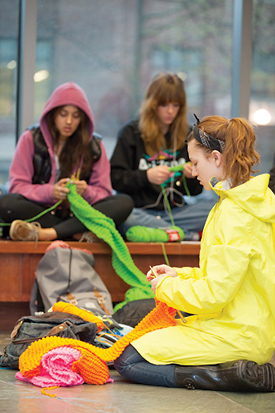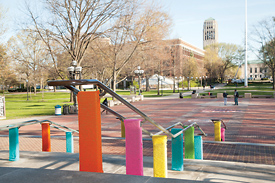

School of Art & Design students Payal Doshi, Cara Phelps and Stephanie O’Neil knit banners that were placed outside of Harlan Hatcher Graduate Library (below) as part of an art installation. Photos by Scott C. Soderberg, U-M Photo Services.
Students installed 10,000 square-inches of colorful hand-knitted banners outside the Harlan Hatcher Graduate Library in a “yarn bomb” project designed to display humanity and handiwork.
The colorful display was for a class taught by Roland Graf, an Austrian artist, architect and designer who has experimented with installations in the center of Vienna and other European cities. Graf, assistant professor of art and design in the School of Art & Design, says the class Concept, Form, Context focuses on “Human Being — Being Human.”
He gave the assignment to transform a space in campus. The group of 19 students, came up with the idea to work together and “yarn bomb,” a temporary knitting installation at the railing posts of the library as a reminder, among other things, that craftsmanship can have similar impact to intellectual pursuit.
Yarn bombing became a trend in the last decade as part of crafitivism, guerrilla art or urban temporary art, and “relates perfectly to the notion of human being or being human in an academic environment at this time of the year, for most students stressful,” Graf says.
“The silliness of yarn bombing, crafting carefully knit clothes around public objects, inspired the class,” says student Sam Oliver. He was inspired about “creating whimsical public art, rather than concept-driven pieces that teachers usually demand.” The project helped to “break through the confines of art school and declare our existence to Ann Arbor.”
Oliver, who knitted several 70-inch banners in marathon sessions in residence halls with classmates, says this class helped to redefine the role “of humanity and handiwork” used to “alter the dynamic of the university.”
For student Nina Pagalot, the repetitive act of knitting together for hours, sometimes not sleeping much, “was very therapeutic” and created a “different group dynamic in which there was no competition, just teamwork.”

